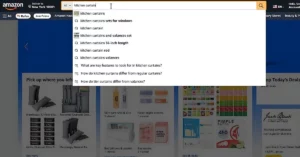
The drop in Amazon seller competition offers new opportunities, but only for those prepared to handle platform changes and increased operating pressure.
Yes, the numbers are down. Amazon seller competition isn’t what it was in 2021.
But before you celebrate, take a look at the terrain. Today’s sellers still face higher costs, tougher rules, and intense price pressure.
Despite that, 60% of Amazon’s sales come from independent sellers, most of them small businesses. In 2024, the average U.S. seller made $290,000, and over 55,000 broke the $1 million barrier. The door is open.
The question is: can you walk through it?
Shrinking Amazon seller competition, rising opportunity
Amazon sellers now face a market with significantly less competition than just a few years ago. Marketplace Pulse, in a recent article, highlighted that active seller numbers have dropped from over 2.4 million in 2021 to under 1.9 million in 2025, even as nearly a million new sellers still join annually.
This decline in active sellers, defined as those who received at least one feedback in the last 12 months, has increased available traffic per seller by over 30%. Traffic per seller rose from 2,162 monthly visits in 2021 to 2,837 in 2025, offering more exposure to each remaining seller.
During the same period, Amazon’s overall traffic remained steady, but its total revenue climbed 36%, from $470 billion in 2021 to $638 billion in 2024. Third-party sellers captured a growing share of this growth, selling 62% of units in Q4 2024 compared to 56% in Q4 2021.
Notably, more than 60% of the top 10,000 sellers on Amazon.com registered before 2019, proving that seller longevity is still the strongest predictor of success. The marketplace is maturing, and those who adapt tend to stay and win.
Marketplace Pulse also notes that while the U.S. retains the highest overall traffic with 2.45 billion monthly visits, some smaller regions now offer better seller-to-traffic ratios:
Saudi Arabia: 8,228 visits per seller
South Africa: 8,065 visits per seller
Singapore: 4,531 visits per seller
However, these smaller markets have lower total traffic volumes, capping their revenue potential and limiting niche diversity.
The shrinking competition comes with its own challenges. Amazon’s rising fees now consume over 50% of many sellers’ revenue, and Chinese sellers, now more than 50% of Amazon.com’s top sellers, are intensifying price pressure as direct-to-consumer manufacturing increases.
Regulatory issues and tariff uncertainty continue to complicate operations. Still, sellers who can navigate these challenges find greater opportunities than they did four years ago.
While newer sellers may not enjoy the same tactics that older sellers used, like incentivized reviews, they now benefit from less saturated markets. The drop in competition may be one of the few advantages left in Amazon’s increasingly complex ecosystem.
Selling on Amazon offers profits, but sellers face ongoing challenges
North One"In 2023, approximately 45% of Amazon sellers generated a monthly revenue between $1,000 and $25,000."
Selling on Amazon can be a profitable venture, but sellers must be prepared to navigate a range of operational challenges. EcommerceBytes recently presented data highlighting sellers’ frustrations following Amazon’s announcement about expanding robotics in its fulfillment centers.
Amazon revealed it has deployed over 750,000 robots to assist with package sorting and handling across its network. The company promoted these robotics as tools to improve safety, efficiency, and delivery speed, including a new fulfillment center in Shreveport, Louisiana, using eight different robotic systems.
Despite this technological progress, many sellers reacted negatively, feeling Amazon’s focus on robotics overlooked pressing seller issues. Common complaints include missing inventory, delayed reimbursements, and problems with case management that have persisted for years.
Sellers report shipments being partially checked in, with examples of hundreds of items sent but only a fraction accounted for. Missing inventory cases often remain unresolved for months, with sellers receiving little to no reimbursement.
Other significant concerns include long delays in processing inbound shipments, return abuses by customers, and charges for return processing on late deliveries. Sellers also criticize Amazon for relying heavily on AI and outsourced support that fails to resolve their issues.
The use of robots has raised questions about inventory management, with sellers pointing out problems like improper labeling and expiration date handling. There is also unease about robots making critical decisions, such as handling A-Z claims, which some feel undermines the quality of customer service.
While automation promises efficiency, many sellers see Amazon’s robotic advancements as part of a broader trend prioritizing company profits over seller support. Sellers worry that new fees may soon follow, despite Amazon’s assurances of no fee increases in 2025.
Amazon has named its robots, including Sequoia, Hercules, and Titan, and encourages sellers to learn more about how these machines operate through its corporate blog. However, without addressing core seller challenges, technology alone is unlikely to win over many in the seller community.
Other challenges for Amazon sellers in 2025
Steven Pope, My Amazon Guy Founder"Selling on Amazon is tough, but it doesn't have to be".
Selling on Amazon can be a profitable venture, but sellers should be prepared to navigate a maze of operational challenges, especially when using Fulfillment by Amazon (FBA). Forbes presented data in an article highlighting how inventory mismanagement and rising fees are tightening the margins for third-party sellers.
One of the biggest pain points is managing replenishment math. Sellers shipping directly from Chinese suppliers often deal with full pallet shipments that can’t be split, triggering maximum placement fees.
FBA also penalizes sellers who miscalculate inventory flow. The moment a shipment is planned in Seller Central, it is counted as stock in FBA, even if it hasn’t moved, complicating restocking strategies from local warehouses.
Throughput, or the rate of sales to inventory, plays a significant role in setting restock limits and fees. These limits are based on a three-month performance window, which is waived for new sellers, but only temporarily.
If sales slow down, restock limits drop just as quickly, which can create a vicious cycle. Additionally, letting inventory drop below a 28-day average triggers extra fees, further straining profitability.
To stay competitive, sellers must maintain a delicate balance of 30 to 60 days of inventory. Overstocking risks long-term storage fees, while understocking invites penalties and missed sales opportunities.
Key strategies to maintain profitability include:
Keeping inventory in the 30–60 day sweet spot
Avoiding oversize SKUs to reduce placement and storage fees
Scheduling inbound shipments to minimize FBA holding time
Launching aggressive ads early to increase throughput and unlock higher restock limits
While FBA lowers infrastructure barriers, the platform demands operational precision—often requiring the support of an experienced Amazon agency. Without strategic planning and financial oversight, many sellers struggle to stay profitable and ultimately exit the platform, contributing to the current trend of decreasing seller competition.






